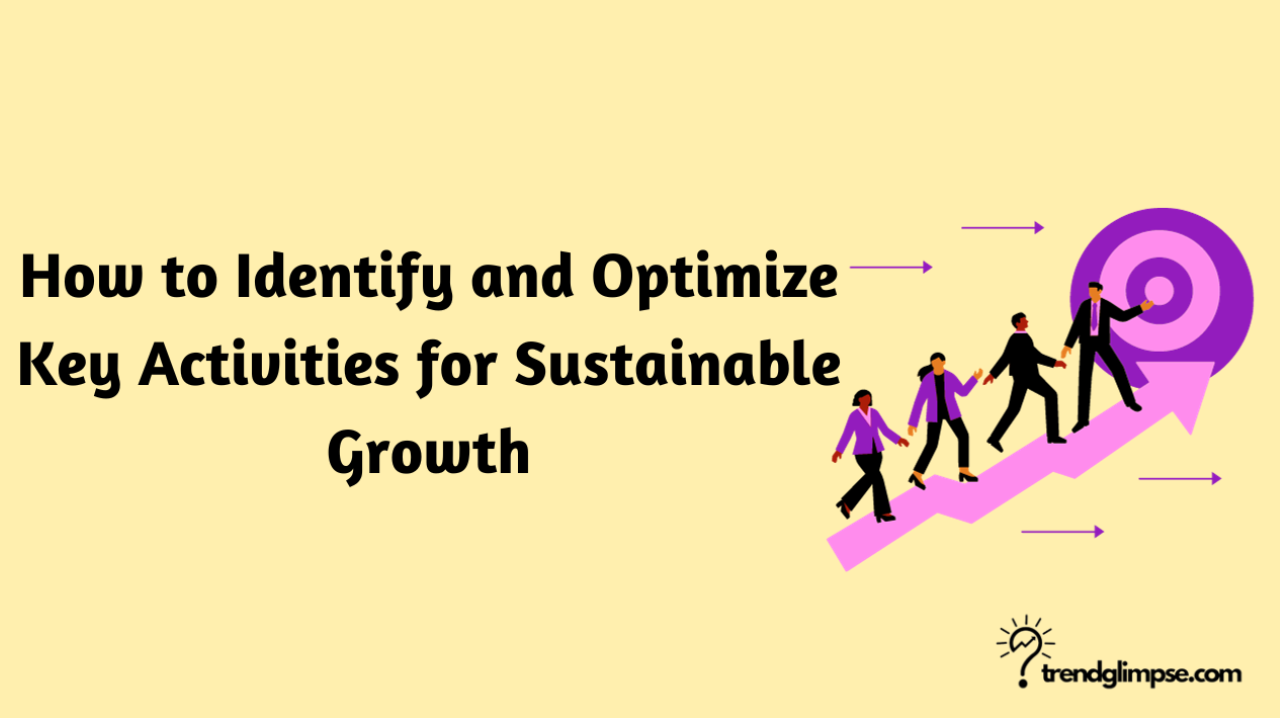Introduction
Growth and scalability don’t happen by accident. To set your business up for long-term, sustainable success, you need to be strategic and thoughtful about how you invest your limited resources.
In this article, I want to have a practical discussion about how to identify the handful of activities that drive the core value in your business so you can double down on them. With some simple frameworks and principles, you’ll leave with clarity on the few key places to focus your energy and capital to fuel steady, manageable growth over the years ahead.
Understand the current state of your business
-What are your current key activities? What’s working well and what isn’t?
-Where are there inefficiencies or bottlenecks?
-What activities drive the most value? Revenue? Customer satisfaction?
Identifying and optimizing key activities is crucial for sustainable business growth. First, closely analyze your current key activities – what processes or tasks are most vital to daily operations and delivering core products/services?
Look at what’s going smoothly and what areas face recurring bottlenecks or quality issues. For example, a software company may find that while product development hums along, long customer support response times result in subscriptions not being renewed.
Next, pinpoint where there are inefficiencies or bottlenecks in workflows. Conduct process mapping to uncover wasted steps that fail to add value. Check for technology constraints or lack of standardization. At this stage, input from frontline employees is invaluable, as they best understand pain points. Our software firm may discover that service agents lose productivity toggling between multiple systems.
Finally, determine what contributes most to top-line growth or customer satisfaction using Pareto analysis. The 20% of activities that drive 80% of outcomes are ones to optimize and invest in first. For many businesses, sales and marketing are key growth accelerators, while speedy issue resolution retains happy customers. Our software company may bolster its support team and tech tools to promptly address user concerns.
Analyze performance data
-What KPIs or metrics can you analyze to spot trends and opportunities?
-Where do you see potential growth areas based on the data?
When looking to identify areas for sustainable growth, start by examining key performance indicators (KPIs) around customer acquisition, retention, and lifetime value. Carefully break down metrics across critical stages of the customer journey to spot potential weak points. For example, are conversion rates declining at the initial signup or purchase phase? Or is churn increasing among long-term high-value customers?
As you analyze the data, pay attention to any changes over time, drill down into underperforming cohorts, and compare against industry benchmarks. Platforms like Mixpanel, Amplitude, and Looker make it easy to segment users and model growth scenarios.
Leading brands use advanced analytics to optimize across the funnel. Subscription businesses may focus on minimizing churn and increasing renewal rates, while e-commerce brands work to improve repeat purchase rates and average order value.
Once you’ve identified potential weak spots, such as a drop in new customers or loss of high-spenders, brainstorm hypotheses, prioritize issues with the biggest revenue impact, and outline tests to address problems. For example, if cart abandonment increases, try optimizing checkout flows or offering targeted discounts to recover lost sales. Continually experiment and scale up efforts demonstrating the best results.
With the right foundation of measurement, analytics, and testing, it’s possible to shift key metrics and unlock more sustainable business growth.
Identify new growth opportunities
-What customer needs are not being fully met yet?
-Are there adjacent markets, products or services worth exploring?
-What activities could open up new streams of revenue?
Successful companies like Amazon continually survey customers and analyze data to spot unmet needs. Then they iterate products and services to fill those gaps. Keep an open dialogue to understand pain points. Observe where customers improvise solutions or cobble together workarounds to fill needs. Those signal opportunities.
Companies like Google and Apple frequently branch into related markets once they establish a strong customer base. Leverage existing capabilities to expand. For example, an online retailer could create private label products. Or a SaaS platform may build integrations, services and partnerships to enter new segments. But stay close to the core business; completely unrelated diversification often fails. Test new offerings with subsets of customers first.
Another thing companies seeking sustainable growth should critically evaluate their offerings to pinpoint opportunities for creating new revenue streams. Analyze the core competencies and resources unique to your organization and determine how these could be leveraged to provide additional value to customers.
Research industry best practices
-What companies in your industry excel at key activities/processes?
-What can you learn from them?
Identifying and optimizing key activities is crucial for any business looking to grow sustainably over the long-term. When we think about companies in our industry that truly excel at certain processes, Amazon immediately comes to mind. Their supply chain and logistics operations are best-in-class – they’ve innovated warehousing, delivery speed and efficiency.
We can certainly learn from their data-driven culture and testing mindset. Before optimizing anything, they gather data to identify problem areas and opportunities. They aren’t afraid to run experiments, even if they might fail, to push boundaries.
Another great example is McDonald’s and their focus on drive-thru operations. They analyze wait times, accuracy, and customer satisfaction metrics at each location to continually enhance the experience. Their knowledge sharing between locations and willingness to try new technologies like automated ordering AI and menu boards allows them to remain leaders in the QSR space when it comes to speed and consistency.
As we look to scale our operations, analyzing our own internal data is the first step. What current processes are resulting in bottlenecks, quality issues or needing lots of rework? By picking 2-3 prime opportunities like this and being willing to pilot changes, we can significantly increase productivity. Continually experimenting and learning from other industry standouts can ensure we’re optimizing the activities that matter most to our business.
Optimize and streamline processes
-How can you improve efficiency in key activities using technology, automation, etc?
-What constraints can you loosen? More resources? Faster throughput?
-Can you outsource/offload any activities to focus more on value-add ones?
Many successful companies like Amazon and Netflix are constantly looking for ways to optimize their key activities through technology and automation. One approach is to analyze your current workflows and identify where automation could reduce manual labor.
For example, automatically collecting and entering customer data rather than manual data entry. Look into workflow management tools and intelligent software that can take over repetitive tasks. Use predictive analytics and machine learning to anticipate upcoming needs and responses. Automate financial, inventory, marketing functions where possible with the latest AI.
Successful growth requires examining what constraints are holding your key activities back currently and exploring how those could be loosened. Look at any activity bottlenecks in terms of resources, budgets, technology limitations or throughput issues.
Explore loosening financial constraints by reworking budgets or securing additional funding to allocate more resources towards growth-driving activities. This could mean hiring top talent, upgrading technology infrastructures or acquisition options.
Assessing which current activities are non-core and could be outsourced is key for freeing up resources to focus on value-adding ones most vital for growth. Administrative tasks like bookkeeping, billing, appointments and more can often be efficiently outsourced to specialized services. Basic customer service and support questions could potentially be handed by AI chatbots as well.
Consider what parts of distribution, marketing, manufacturing could be reliably delivered by external partners. Successful startups like Uber built growth by offloading driver management to a contractor model. While focusing internal efforts on innovation, identify non-central activities to outsource and redirect those resources towards perfecting value-adding differentiators essential to sustainable success.
Pilot and test changes before scaling
-Try out process improvements through A/B testing or minimum viable changes first
-Monitor performance impact and get feedback from team
-Tweak before full rollout if needed
When looking to identify and optimize key activities for sustainable growth, it’s important to take an iterative approach. Rather than overhauling processes all at once, companies like Amazon and Toyota have found success through continual small tests and tweaks over time.
First, try out process improvements through A/B testing or minimum viable changes. For example, a company could test out a new customer referral program with a small segment of customers instead of launching it to the entire customer base right away. This allows you to measure performance impact and get feedback on a small scale before deciding whether to continue tweaking the program or do a full rollout.
Next, closely monitor the performance impact of these small changes and get qualitative feedback from the teams testing them. Key metrics to track could include customer satisfaction scores, sales or conversion rates, and employee productivity. Toyota, for instance, empowers factory floor workers to identify inefficiencies and suggest process improvements.
You can then use the insights gleaned to determine whether the changes should be tweaked based on the feedback before considering a wider rollout. This build-measure-learn approach helps optimize activities over time while minimizing risk. Continual small tests allow for correction of course and identification of the most impactful changes for sustainable growth.
Conclusion
And there you have it – by focusing in on those vital few key activities that drive exponential growth and continuously innovating and improving those levers, you set your company up for scalable, sustainable gains.
It takes diligent monitoring of leading and lagging indicators, but identifying and doubling down on your breakthrough moments paves the way for compounded expansion and allows you to fulfill your company’s purpose over the long-term. Staying fixated on the essential drivers, rather than getting distracted by less impactful efforts, keeps your organization aligned, efficient and consistently upleveling.

I have always been fascinated by the inner workings of companies and industries. So I decided to study business to explore it more. My goal is to take all my research and turn it into cool stories that give people a better understanding of the business world.

